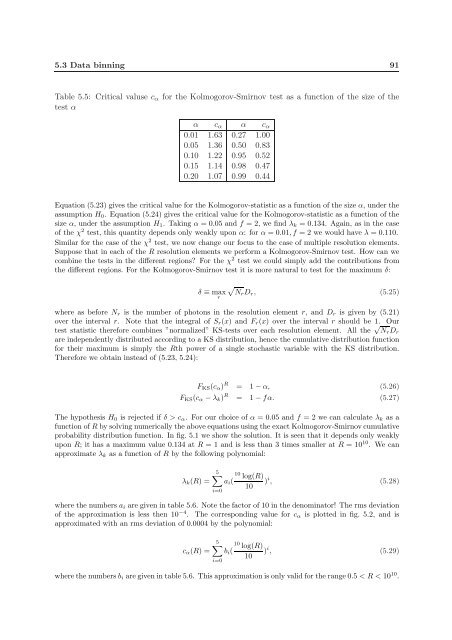SPEX User's Manual - SRON
SPEX User's Manual - SRON
SPEX User's Manual - SRON
You also want an ePaper? Increase the reach of your titles
YUMPU automatically turns print PDFs into web optimized ePapers that Google loves.
5.3 Data binning 91<br />
Table 5.5: Critical valuse c α for the Kolmogorov-Smirnov test as a function of the size of the<br />
test α<br />
α c α α c α<br />
0.01 1.63 0.27 1.00<br />
0.05 1.36 0.50 0.83<br />
0.10 1.22 0.95 0.52<br />
0.15 1.14 0.98 0.47<br />
0.20 1.07 0.99 0.44<br />
Equation (5.23) gives the critical value for the Kolmogorov-statistic as a function of the size α, under the<br />
assumption H 0 . Equation (5.24) gives the critical value for the Kolmogorov-statistic as a function of the<br />
size α, under the assumption H 1 . Taking α = 0.05 and f = 2, we find λ k = 0.134. Again, as in the case<br />
of the χ 2 test, this quantity depends only weakly upon α: for α = 0.01, f = 2 we would have λ = 0.110.<br />
Similar for the case of the χ 2 test, we now change our focus to the case of multiple resolution elements.<br />
Suppose that in each of the R resolution elements we perform a Kolmogorov-Smirnov test. How can we<br />
combine the tests in the different regions? For the χ 2 test we could simply add the contributions from<br />
the different regions. For the Kolmogorov-Smirnov test it is more natural to test for the maximum δ:<br />
√<br />
δ ≡ max Nr D r , (5.25)<br />
r<br />
where as before N r is the number of photons in the resolution element r, and D r is given by (5.21)<br />
over the interval r. Note that the integral of S r (x) and F r (x) over the interval r should be 1. Our<br />
test statistic therefore combines ”normalized” KS-tests over each resolution element. All the √ N r D r<br />
are independently distributed according to a KS distribution, hence the cumulative distribution function<br />
for their maximum is simply the Rth power of a single stochastic variable with the KS distribution.<br />
Therefore we obtain instead of (5.23, 5.24):<br />
F KS (c α ) R = 1 − α, (5.26)<br />
F KS (c α − λ k ) R = 1 − fα. (5.27)<br />
The hypothesis H 0 is rejected if δ > c α . For our choice of α = 0.05 and f = 2 we can calculate λ k as a<br />
function of R by solving numerically the above equations using the exact Kolmogorov-Smirnov cumulative<br />
probability distribution function. In fig. 5.1 we show the solution. It is seen that it depends only weakly<br />
upon R; it has a maximum value 0.134 at R = 1 and is less than 3 times smaller at R = 10 10 . We can<br />
approximate λ k as a function of R by the following polynomial:<br />
λ k (R) =<br />
5∑ 10 log(R)<br />
a i ( ) i , (5.28)<br />
10<br />
i=0<br />
where the numbers a i are given in table 5.6. Note the factor of 10 in the denominator! The rms deviation<br />
of the approximation is less then 10 −4 . The corresponding value for c α is plotted in fig. 5.2, and is<br />
approximated with an rms deviation of 0.0004 by the polynomial:<br />
c α (R) =<br />
5∑ 10 log(R)<br />
b i ( ) i , (5.29)<br />
10<br />
i=0<br />
where the numbers b i are given in table 5.6. This approximation is only valid for the range 0.5 < R < 10 10 .

















